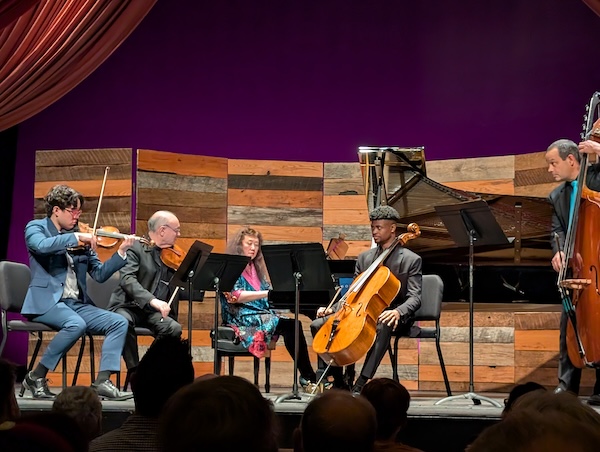Wu Han & friends close Wolf Trap tenure with typically thoughtful program

Pianist Wu Han and colleagues performed Schubert’s “Trout” Quintet Sunday at Wolf Trap. Photo: C. Downey
Pianist Wu Han is concluding her final season as artistic advisor for the chamber music series at Wolf Trap, a position she took up in the 2018-2019 season. On Sunday afternoon, at the last concert in the Barns where she will perform in this capacity, she spoke of how much she has appreciated the audience growing during her tenure.
“I lose sleep over programming,” she told the sold-out audience with a laugh, after explaining her ideas behind the day’s concert. Her care is evident in the repertoire, and the audience showed its gratitude in turn for the quality of programming she has brought over the years. With a twinkle in her eye, she confided that this is goodbye and not farewell, hinting that she will be back to perform at Wolf Trap at some point next season.
One of the highlights of Wu Han’s leadership has been the chance to hear a number of programs imported from the Chamber Music Society of Lincoln Center, such as this concert offered. Five string players joined her on stage for a program that culminated in a Mozart piano quartet and Schubert’s beloved “Trout” Quintet.
First, though, came two rather obscure contrapuntal exercises, both owing their existence to Mozart. The Austrian composer, in his period of obsessive study of baroque music, arranged a Fugue in F Minor by Wilhelm Friedemann Bach for string trio. Violist Paul Neubauer played the initial statement of the subject, preemptively accompanied by the countersubject material given to cellist Sterling Elliott, before passing to violinist Arnaud Sussmann. The extended treatment of the theme, including an inverted statement, justified Mozart’s interest.
For comparison, the program next moved to the Adagio and Fugue in C Minor by Mozart himself, in an offbeat arrangement Mozart made for two violins, viola, and double-bass. Bassist Anthony Manzo made his presence known with a growling low note to open the eclectic Adagio, which led into the capably realized Fugue, originally composed first by Mozart in a version for two pianos. Violinist Julian Rhee joined Sussmann and Neubauer among the upper parts, which largely functioned as a unit together. Mozart even included a section in stretto, where the subject was layered over itself at a more rapid pace.
Mozart’s study of baroque counterpoint, facilitated by consulting the score collection of his friend and supporter Gottfried van Swieten, bore fruit in parts of his Piano Quartet No. 2, which followed. Sussmann, Neubauer, and Elliott maintained a collegial balance, against which Wu Han, seated at the Steinway Hamburg Model D she helped Wolf Trap acquire in 2022, wove in and out with delicate runs in the genial first movement. The build-up to the recapitulation of the main themes, made with a dramatic crescendo, proved especially satisfying.
The three string players excelled in the sections without piano, a significant part of the extended slow movement. A number of contrapuntal exchanges here stood out in a different light, following the focus on Mozart’s interest in fugue. In a different approach than when Wu Han played this piece last season, with different string players, the musicians went with a more relaxed tempo for the third movement, which heightened its playful qualities.
The banner work, Schubert’s Piano Quintet in A major (“Trout”), is an oddity in many ways among the chamber music repertory. The string personnel in this case, with Julian Rhee on violin and Manzo on double-bass, did not meld together as effortlessly in terms of ensemble and intonation, quite noticeable in the first movement. The second movement had its struggles as well, although an extended section for viola-cello duet featured lovely restrained sounds from Neubauer and Elliott.
The same was true of the third movement, a quick-footed Scherzo, although the suaver Trio section fared better. The group had its greatest success in the fourth movement, a set of variations on Schubert’s song “Die Forelle,” which gave the quintet its nickname. Elements from the song, describing a trout in a stream that is hooked by a clever fisherman, run through the other movements, but here all the instruments got a turn with this pleasing melody and the slithering accompaniment line that is its hallmark.
The fifth movement, as it often does, nearly tricked the audience into applauding at its halfway point, despite Wu Han having warned us about this very moment. Schubert simply repeated the same music in a different key to conclude the movement, another reminder of the unusual structure of this singular work.
Violinist Julia Fischer and pianist Jan Lisiecki perform violin sonatas by Mozart, Beethoven, and Schumann 7:30 p.m. March 26. wolftrap.org

